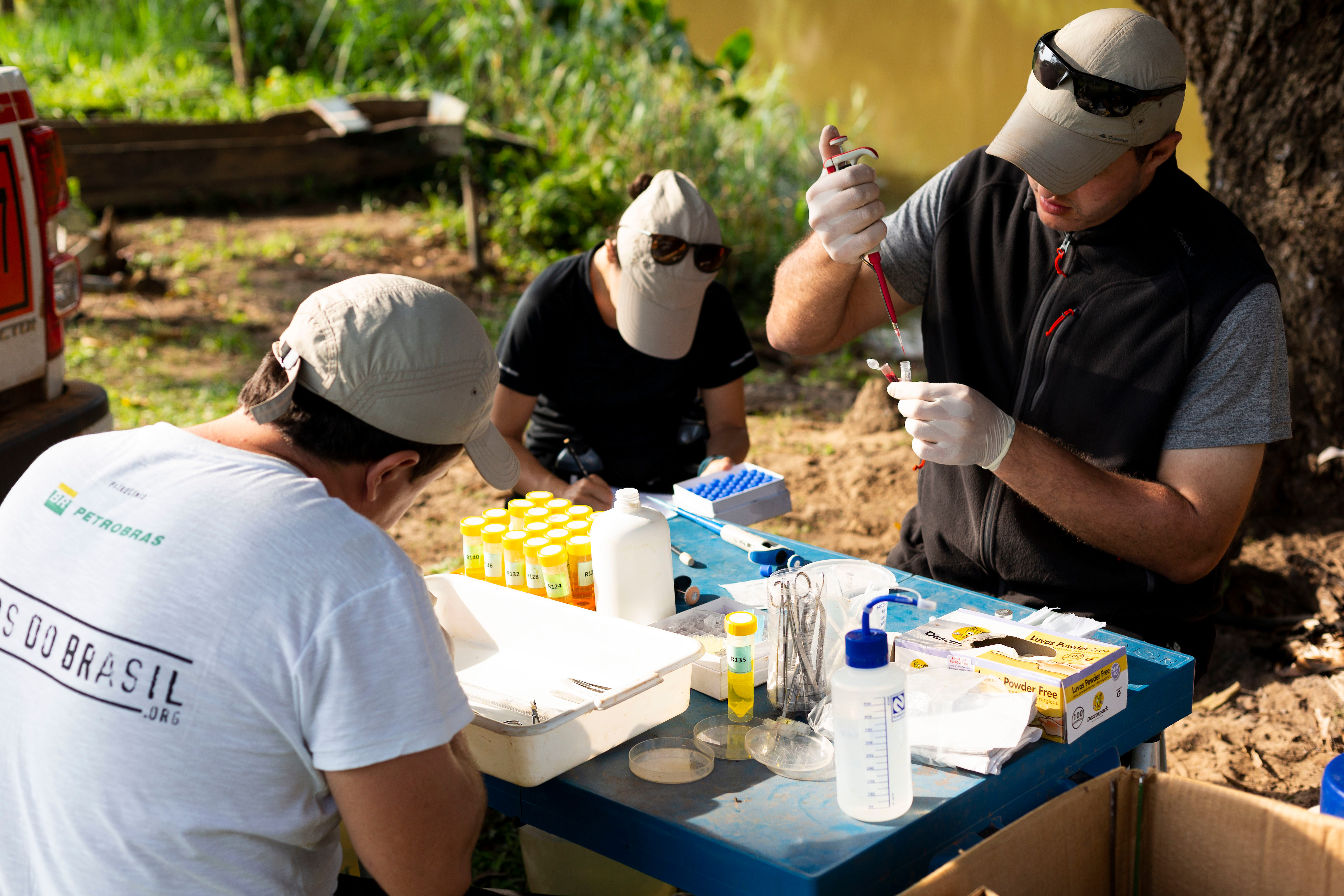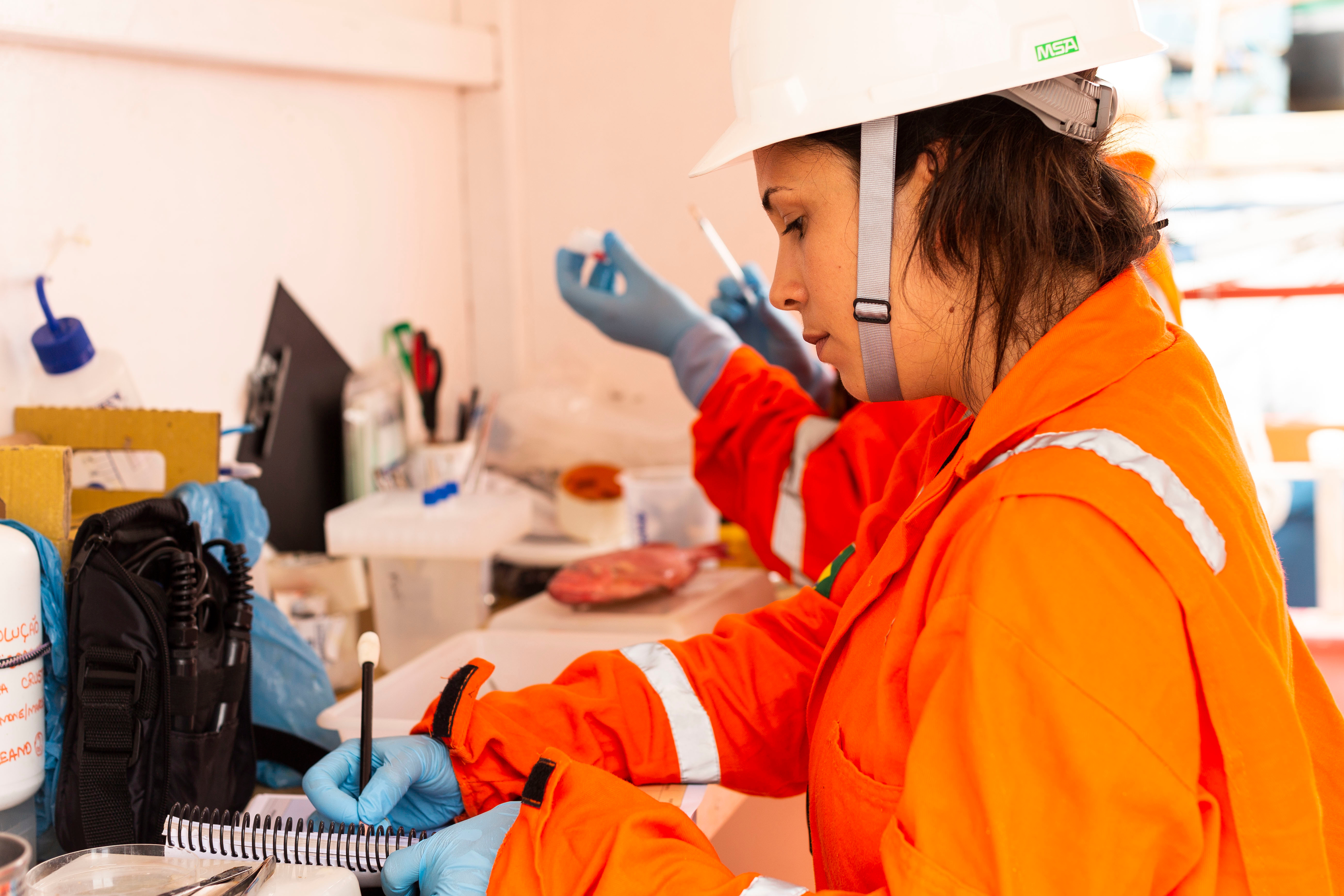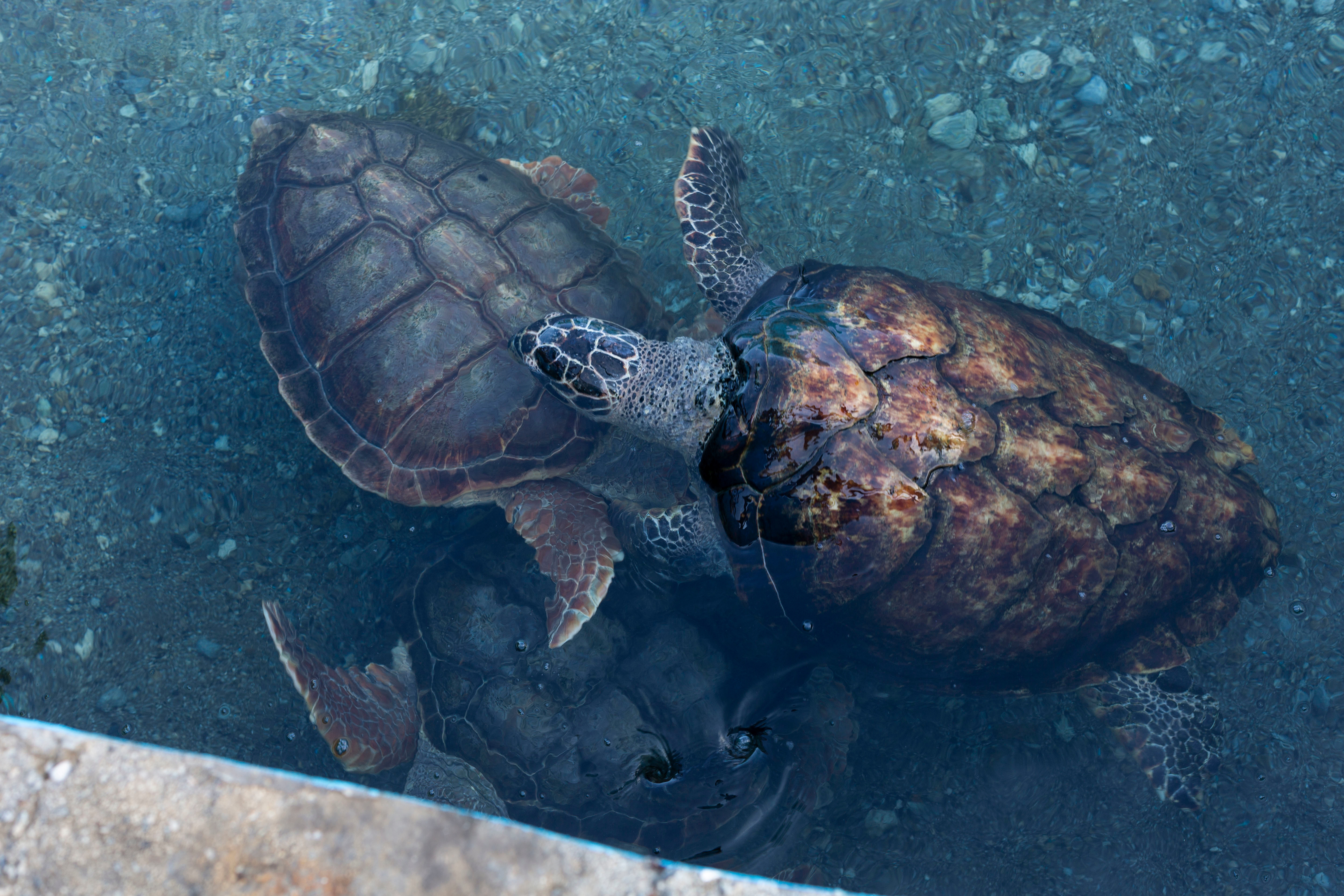Linhares
Know to act
Data analysis allows us to state that water can be consumed after treatment and opens the way to examine biodiversity and reflections at the Doce River mouth in Linhares (ES).
Linhares
Sixteen days after the Fundão dam failure in Mariana (MG), half of the tailings reached the mouth of the Doce River, in Regência, in the municipality of Linhares (ES), and reached the sea. A new chapter began in the history of the district, home to about 1,000 people, who at that time depended mainly on fishing and tourism-related activities.
It is no coincidence that the region of the mouth, surrounded by the river and the sea, is one of the most accompanied by the Renova Foundation. The main instrument for this is the water monitoring program, implemented two years ago and which assesses water conditions in the Doce River basin.
The volume of reports generated by the program (about 1.5 million data per year) and the structure used allow us to state that Doce River water can be consumed after undergoing conventional treatment in the municipal supply systems – as indeed, occurs with any raw water. This conclusion is based on the analysis of the information collected, which is sent daily to environmental agencies.
Today, the Doce River basin is the most monitored in the country. There are 80 physical, chemical and biological parameters studied in 92 points, from Mariana to the mouth, 22 of them verified by automatic stations, which generate information in real time. Another 40 parameters evaluate sediments. The data set supports the preventive planning of the basin supply systems and shows how the Doce River is recovering. Two teams, in Mariana and Linhares, take care of the databases generated by the monitoring.
Water monitoring
92 point monitoring on affected watercourses
Brígida Maioli
Expert explains Doce River monitoring program (in portuguese)
Information is shared with environmental agencies. Since March 2019, data have also been made available on the Renova Foundation website. Five agencies participate in this work through a Technical Follow-up Group (GTA): National Water Agency (ANA), Brazilian Institute of Environment and Renewable Natural Resources (Ibama), Chico Mendes Institute for Biodiversity Conservation (ICMBio), Minas Gerais Institute for Water Management (Igam) and State Water Resources Agency of Espírito Santo (Agerh).
Water monitoring program generates 1.5 million data per year
Regina Pimenta Assunção, coordinator of the Technical Chamber for Water Safety and Water Quality, an advisory body linked to the Minas Gerais Institute for Water Management (Igam), states that the monitoring program has been studied and planned according to the experiences of the managing bodies of environment and water resources.
“The objective is to follow the evolution of water quality parameters over time. We have 22 automatic stations, which transmit daily data and are flags in case of contingency. Today, it is the most evolved and complete monitoring in the country,” says Regina. “The water is fit for human consumption after conventional treatment at Water Treatment Stations (WTSs) all along the Doce River,” she adds.
She explains that after the peak of turbidity in water quality indices recorded in November 2015, shortly after the failure, “values dropped precipitously” in early 2016, within the limits set by Resolution 357 of the National Environmental Council (Conama).
Since mid-2017, most of the Doce River stretches have met the parameters according to legal values, with sporadic turbidity peaks and elements such as dissolved iron, total manganese, dissolved aluminum and total lead. According to Igam, the section that requires more attention and repair actions (already in progress) is in the area located before the Risoleta Neves Hydroelectric Power Plant (known as Candonga), which comprises the Gualaxo do Norte, Carmo and Doce rivers. The best water quality of the Doce River is now in the area after the municipality of Governador Valadares (MG) to the border with the state of Espírito Santo. “We can see that there is a trend of significant improvement in the water quality of the Doce River,” says the coordinator.
“The water is fit for human consumption after conventional treatment in WTSs throughout the Doce River.”
REGINA ASSUNÇÃO, TECHNICAL CHAMBER COORDINATOR
SUPPLY SYSTEM
Linhares, the last city on the Doce River road to the sea and an important tourist destination in Espírito Santo, reflects the results of the Renova Foundation’s water security front.
Regência and Povoação, two districts of Linhares located at the mouth, are resuming tourism activities. In addition to the summer programming in the region and cultural events of a historical nature, which receive support from the Renova Foundation, such as the Caboclo Bernardo Party, the mouth reaffirms its leading role in surfing in Espírito Santo.
Since 2018, the beaches of Povoação, Pontal do Ipiranga and Regência have once again played host to the Triple Crown Break Wave Surf Circuit, an event that is an important milestone for the resumption of sports and for the strengthening of tourism and the local economy. The competition attracts sports fans and includes professional surfers.
As for supply, at the end of 2016, an alternative water supply structure was delivered to Linhares, located in Lagoa Nova, with a capacity to meet about 50% of the city’s consumption. This alternative water collection contributes to reducing dependence on the supply of the Pequeno River, which connects with Doce.
Regência´s Water Treatment Station (WTS), Linhares district, has also been renovated and modernized. The interventions were finalized in 2017, and after more than 100 water quality tests carried out in 2018 and evaluated by Linhares Autonomous Water and Sewerage Service (SAAE) – the municipal authority responsible for water catchment, treatment and distribution – and by the Public Prosecution Service of the State of Espírito Santo (MPES), it was approved by the agencies the mix of waters coming from SAAE and WTS. The structure reduces the risk of shortages at times when users are increasing due to tourism.
Water quality and sporting and cultural events are the way to leverage the local economy, according to Fabrício Fiorot, owner of a Regência inn. Despite knowing the size of the challenge, he believes the events are important attractions for tourists and surfers to return to the district. Fabrício has already prepared to meet the demand, increasing by about 30% the capacity of occupancy of the inn. “I invested to increase the number of rooms and improve service. With information on actions to improve water, the tendency is to increase the reliability of people, and consequently the movement as well. I believe in Regência and so I keep investing here,” says Fiorot.
“I believe in Regência, so I keep investing here.”
FABRÍCIO FIOROT, OWNER OF AN LODGING IN REGÊNCIA
FOCUS ON BIODIVERSITY
In order to monitor biodiversity and to make diagnoses of the impacts caused by the Fundão dam rupture that allow the establishment of guidelines for the preservation of the basin’s ecosystems along the Doce River, at the mouth and in the coastal zone, about 580 people from 25 universities in the country, have been mobilized since September 2018. The Renova Foundation signed a Technical-Scientific and Financial Cooperation Agreement with the Espírito Santo Technology Foundation (Fest) and the Federal University of Espírito Santo (Ufes) to fund this research project.
The Rio Doce Mar Network monitors physical and chemical aspects of the environment and biodiversity at about 200 points along the entire Espírito Santo portion of the Doce River and in the estuarine, coastal and marine regions, which comprise the mouth and the surrounding area from Guarapari (ES) to Porto Seguro (BA).

In the picture the biodiversity monitoring team. | Photo: NITRO

In the picture the biodiversity monitoring team. | Photo: NITRO

In the picture the biodiversity monitoring team. | Photo: NITRO

In the picture the biodiversity monitoring team. | Photo: NITRO

In the picture the biodiversity monitoring team. | Photo: NITRO

In the picture the biodiversity monitoring team. | Photo: NITRO
With this detailed study, it will be possible to draw conclusions for the communities and guide the reparation actions, such as the consumption of fish for food and the release of fishing of native species without threat to the local fauna, for example. The joint analysis of the collected data will also serve as a subsidy for forest restoration, as it will provide inputs to define areas for forest restoration.
In the study, small, medium and large drones, aircraft and vessels are used. In addition, there are sensors of various types, satellite images and automated buoys equipped with specific instruments for this type of monitoring.
BIODIVERSITY MONITORING
Gilberto Fonseca Barroso, professor of Federal University of Espírito Santo state and coordinator of monitoring of river and lakes area at the Rio Doce Mar, says that this is an unprecedented work in the country and with few cases in the world. “It is a large and complex study, with collections and analysis of molecules to whales. It is a reference because, besides being comprehensive, it integrates the knowledge of the river and marine environment, which is fundamental for the recovery of the Doce River. The initiative can serve as a model for other basins in the country that live in a process of constant degradation and risk,” he explains.
“The biodiversity study can serve as a model for other basins in the country that are in a process of constant degradation and risk.”
GILBERTO BARROSO, Coordinator of RIO DOCE MAR network
An important parameter for assessing biodiversity in the region, sea turtle spawning, which takes place in the mouth region and on the coast of Espírito Santo, is carefully monitored by the Renova Foundation. The region is one of the main turtle spawning grounds in the country.
In order to assess the impacts of tailings that came from the Doce River and reached the sea, Renova and the Pró-Tamar Foundation signed an agreement to monitor turtle behavior in an area of 159 kilometers of beach in Espírito Santo, from Aracruz to Conceição da Barra. Habits such as reproduction, feeding and spawning are closely monitored to identify any changes in the dynamics of the animal, which has become a symbol of preservation in the region.
Among the monitored sites are areas such as Train Biological Reserve, Train Indigenous Land, Povoação, Monsarás, Cacimbas, Ipiranga, Ipiranguinha, Pontal do Ipiranga, Barra Seca / Urussuquara, Campo Grande, Barra Nova and Guriri. The activities mobilize local labor – fishermen and traditional coastal residents – to detect and monitor females, nests and turtle babies, taking into account the knowledge of the population.
Fundação Pró-Tamar

Renova and the Pro-Tamar Foundation signed an agreement to monitor turtle behavior to assess the impacts of the tailings that came down the Doce River and reached the sea. | Image: NITRO

Sea turtles in a tank at ICMBIO, in partnership with the Pro-Tamar Foundation | Image: NITRO

Habits such as reproduction, feeding and spawning are strictly monitored by the Pro-Tamar Foundation. | Image: NITRO

An important parameter for assessing biodiversity in the region, sea turtle spawning, which takes place in the river mouth region and on the coast of Espirito Santo, is carefully monitored by the Renova Foundation. | Image: NITRO

An important parameter for assessing biodiversity in the region, sea turtle spawning, which takes place in the river mouth region and on the coast of Espirito Santo, is carefully monitored by the Renova Foundation. | Image: NITRO
The first results of the Pró-Tamar Foundation, in late 2018, showed that the number of females with reproductive behavior, nests and turtle babies remained the same when compared to the period before the Fundão dam rupture in Mariana (MG). The survey is conducted throughout the year and reinforced in the turtle-nesting phase from September to March.
There are 670 kilometers in the Doce River basin observed and studied by the Renova Foundation, which allows planning of actions and opens space for engagement, community effort and participation of all involved. The set shows that the river responds positively to these initiatives.